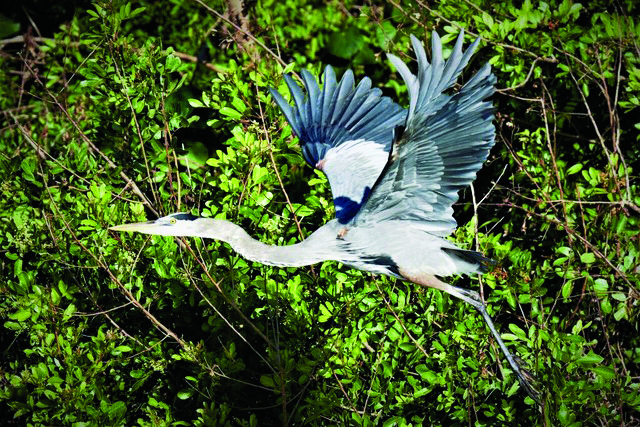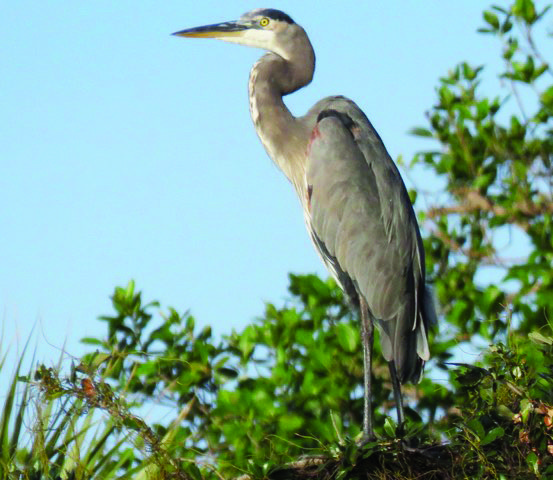By Capt. Chris Thalmann Contributing Writer
This month I thought we’d take a closer look at one of Palm Beach County’s largest birds – the great blue heron. The great blue is truly a big bird. Fully grown, they’re 4 1/2 feet tall with a wingspan of 6 1/2 feet. They’re the largest of the herons here in South Florida and among the very largest of our wading birds. Only the sandhill crane is bigger. Despite their size, great blues are some of the stealthiest ambush hunters you’ll see. Lightning fast when they strike, they will also stand as still as a statue for long periods of time, waiting for the perfect moment. Their weapon of choice is a 6 inch long bill that they use to both spear and grab their prey. Once a great blue has fixed their sights on the next meal it’s just a matter of time until the hunt is complete and it’s time to eat. If they do happen to miss on their first strike, they’ll hit their prey again and again until dinner is served – raw and wriggling. Great blues eat just about anything that moves and will fit into their bill and throat. Fish, frogs, lizards, insects and invertebrates, small mammals, other birds, even young alligators fall prey to these birds. Their extensive diet allows them to be found in all of the lower 48 states, at least seasonally. They’re also found as far north as Alaska in summer. Here in South Florida, most of our great blues are year-rounders. There’s a lighter colored variant in The Keys and very southern South Florida. But here in Palm Beach County it’s the bird’s large size and its bluish-grey body color that will generally tell you it’s a great blue. Dark blue shoulders, a white head, and a distinct dark-blue patch sitting on top of their heads are all common features as well. Great blues are often seen wading along freshwater, saltwater and brackish shorelines or perching in trees just above these areas. Occasionally, you might even see them in your yard, prowling silently for tasty snacks. Takeoffs can be awkward as it takes a little while to get that much bird moving. Yet once in the air, great blues are both powerful and delicate fliers. Watching one land at the top of a small tree shows just how amazingly precise and coordinated these birds are. Despite their size, great blues are among the most skittish birds around and often avoid people, pets, and busy places. That means to see them you’ll need to be a little stealthy too. One of the best places to see great blues in Palm Beach County is Wakodahatchee Wetlands in Delray Beach. The birds roost in colonies there and are busy taking care of their young, giving people a chance to see them up-close. Enjoy your month, hope to see you on the water!



Captain Chris Thalmann
Owner | Aqua Adventure Tours, Inc. • aquaadventuretours.com

